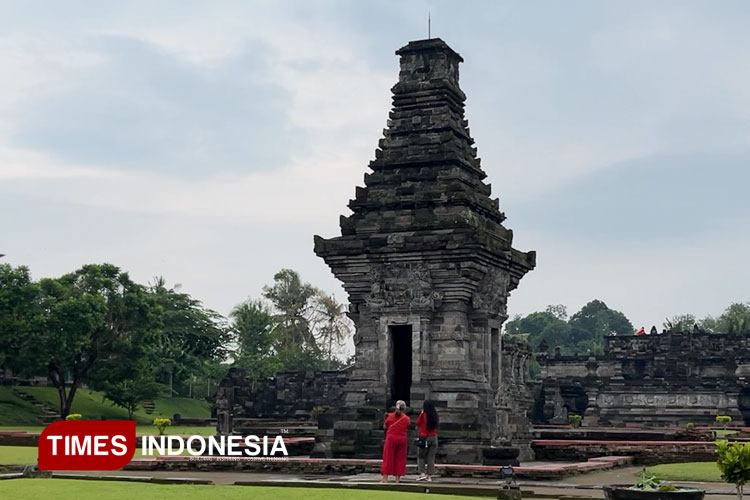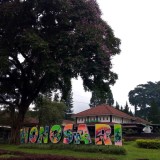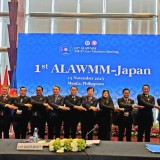TIMES JAZIRAH, BLITAR – Penataran Temple, located in Penataran Village, Nglegok District, Blitar Regency, stands as a major surviving relic of the Majapahit Kingdom. The complex, constructed between the 13th and 15th centuries AD, remains well-preserved today.
The sacred structure originally served as a place of worship for Lord Shiva, also known as Batara Gurunata. Its location on the slopes of Mount Kelud was believed to symbolize the kingdom's protection from natural disasters and represent the fertility of East Java.
Kholam Shiharta, a local cultural expert and artist, explained that Penataran Temple is a vital archaeological site demonstrating the strong connection between nature and the spirituality of Majapahit-era society.
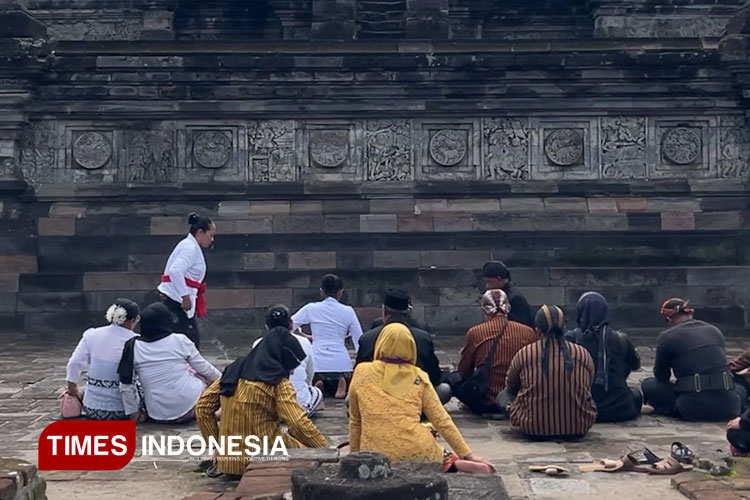 The Youth Pledge committee conducts a prayer procession and slametan (a traditional Javanese ceremony) in front of the Main Temple at Penataran, Blitar, October 27, 2025. (PHOTO: Ardana Pramayoga/TIMES Indonesia)
The Youth Pledge committee conducts a prayer procession and slametan (a traditional Javanese ceremony) in front of the Main Temple at Penataran, Blitar, October 27, 2025. (PHOTO: Ardana Pramayoga/TIMES Indonesia)
"Penataran Temple was not only a place of worship but also a spiritual center for the kingdom. Its location facing the mountain reflects the balance between humans and nature," said Kholam.
According to him, the existence of Penataran Temple enriches the architectural evidence of the Hindu-Buddhist period in East Java and serves as an important resource for national historical research.
Structure, Reliefs, and Architectural Significance
Penataran Temple was built with a mandala structure consisting of three main courtyards. Each courtyard has its own spiritual function, ranging from a place of purification to the primary location for ceremonies. The complex is constructed from blackish-gray andesite stone featuring fine Majapahit-style carvings.
Kholam Shiharta stated that every relief on the temple walls holds symbolic meaning. Many of them depict stories from the Ramayana and Krisnayana, which were used as a means of moral education for the people of that time.
"The carvings at Penataran Temple illustrate life values and the teachings of dharma. These reliefs served as a visual teaching medium that was easily understood by the community," he said.
Another distinct feature is the temple's fusion of Hindu and Buddhist elements. This style, known as Majapahit syncretism, indicates that the society at that time lived with a high degree of inter-religious tolerance.
Beyond its spiritual function, Penataran Temple also held political significance. The Nagarakretagama, an old Javanese epic poem, records that King Hayam Wuruk of Majapahit visited the site in 1359 AD. This visit affirmed the temple's position as an important center for royal religious activities.
Kholam added that the temple's existence is proof that the Javanese concept of sanctity was intrinsically linked to the balance between power and morality.
"Every Majapahit king had a responsibility to maintain the relationship between humans, nature, and God. Penataran Temple became the center for implementing those teachings," he said.
The Role of Penataran Temple in the Modern Era
Today, Penataran Temple is a popular historical tourism destination visited by both domestic and international tourists. The local government, in collaboration with the Cultural Heritage Preservation Agency (Balai Pelestarian Cagar Budaya), continuously carries out maintenance to preserve the stone structures and reliefs.
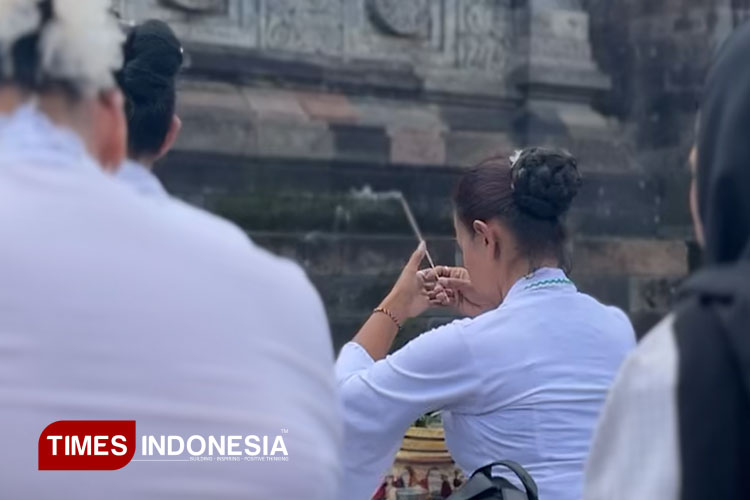 Visitors participate in a communal prayer session at Penataran Temple, Blitar, on October 27, 2025. (PHOTO: Ardana Pramayoga/TIMES Indonesia)
Visitors participate in a communal prayer session at Penataran Temple, Blitar, on October 27, 2025. (PHOTO: Ardana Pramayoga/TIMES Indonesia)
In addition to tourism, the site is still used by the surrounding community for cultural and spiritual activities, such as selamatan bumi (a traditional ceremony to give thanks to the earth) and the commemoration of traditional holidays.
"The cultural rituals at Penataran Temple are a form of preserving ancestral values. The community does not just make pilgrimages; they also maintain harmony with the environment," Kholam Shiharta explained.
In his view, Penataran Temple plays an important role in historical education and cultural tourism in East Java. Through proper management, he added, the site can strengthen regional identity and increase the younger generation's understanding of Majapahit heritage.
For Kholam, conservation efforts for the temple are not merely about preserving the physical buildings but also about protecting the values of wisdom contained within them.
"Penataran Temple teaches the importance of life balance. From here, we can understand how our ancestors placed culture and spirituality in harmonious alignment," he concluded. (*)
Artikel ini sebelumnya sudah tayang di TIMES Indonesia dengan judul: Majapahit Heritage Lives On Through Blitar’s Historic Penataran Temple
| Writer | : TIMES Magang 2025 |
| Editor | : Khodijah Siti |
